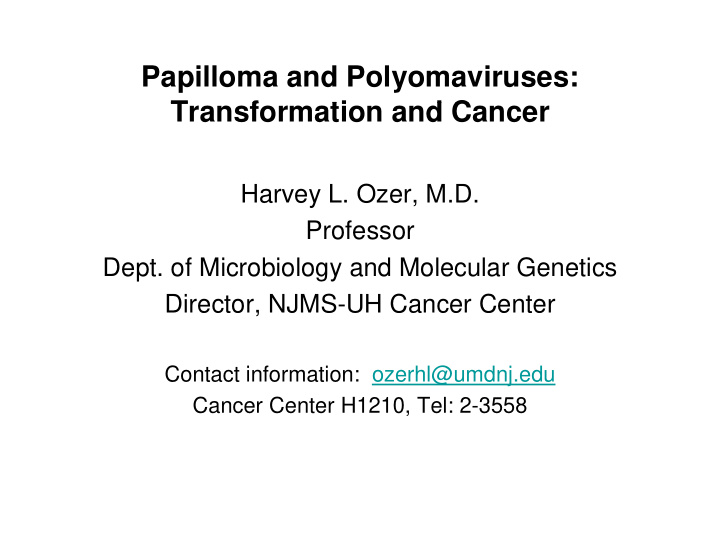



Papilloma and Polyomaviruses: T Transformation and Cancer f ti d C Harvey L. Ozer, M.D. Professor Dept. of Microbiology and Molecular Genetics Director, NJMS-UH Cancer Center , Contact information: ozerhl@umdnj.edu @ j Cancer Center H1210, Tel: 2-3558
Papovaviruses 1. Classification: Polyoma, SV40, papilloma viruses 2. Historical perspective: SV40 as a probe for cellular functions 3 3. Host range: replication and “transformation” Host range: replication and transformation 4. Role of multifunction early viral proteins and transformation 5. Are papovaviruses human tumor viruses
Classification: Polyoma, SV40, papilloma viruses Papovaviruses p
Papovaviruses Papovaviruses Polyoma Viruses Papilloma 200 ? * * JC,BK C Py MCPyV SV40 HPV HPV HPV Multiple (human) (mouse) (human) (primate) 6,11 16,18 cutaneous species CD CIN
Papovaviruses p Historical perspective: SV40 as a probe for cellular functions
Historical perspective 1. Risk of primary cell sources (AGMK) 2. Definition of specificity of restriction sites (Nobel Prize) 3. First sequenced genome 4. Deletion mutants and functional map (colinearity) 5 5. Probe for host functions Probe for host functions a. Nuclear localization signal b. (Confirmed) splicing c. Identification of enhancer sequences (Py, SV40) d. Development of in vitro DNA replication d D l t f i it DNA li ti e. co-IP –Rb, p53, others 6. Model of a DNA tumor virus a. Role of viral ts (tsA) mutants a. Role of viral ts (tsA) mutants
Host Range: Replication and “Transformation”
Papovaviruses Host range: replication and “transformation”: SV40 permissive infection = lytic/monkey cell SV40 non-permissive infection = transformation/mouse 3T3 cells SV40 non permissive infection transformation/mouse 3T3 cells SV40 (semi-permissive) infection = lytic vs transformation/human diploid fibroblasts Role of temperature-sensitive (ts) mutants Papillomaviruses (HPV) and cell differentiation Papillomaviruses (HPV) and cell differentiation
Papovaviruses Host range: replication and “transformation”: SV40 permissive infection = lytic/monkey cell
Papovaviruses Host range: replication and “transformation”: SV40 non-permissive infection = transformation/mouse 3T3 cells Intergration of viral genome SV40 (semi-permissive) infection = lytic vs transformation/human diploid fibroblasts Role of temperature-sensitive (ts) mutants
SVtsA/3T3 SV/3T3 33 o C 33 o C 37 o 37 o Cell Number confluent co ue t confluent confluent Time in days Time in days
Papillomaviruses (HPV) and cell differentiation Papovaviruses
Role of Multifunction Early Viral Proteins and Transformation
Papovaviruses Role of multifunction early viral proteins and transformation: Inactivation of cell growth suppressor What is pRb What is pRb What is p53 Different strategies to a common end SV40 early region (T,t), telomerase, (Sen6) and mutant ras (Hahn and Weinberg)
Comparison of HPV low high cervical i l cervical i l cancer cancer genome 6, 11 16, 18 p53 level 53 l l normal l l low ubiquitin E2 no yes DNA status episomal integrated telomerase no induced
Are Polyomaviruses (esp. SV40) DNA tumor viruses y ( p ) or Why is there still uncertainty about SV40 and mesotheliomas
Papovaviruses Are papovaviruses human tumor viruses: Are papovaviruses human tumor viruses: HPV and cervical carcinogenesis (Zur Hausen) human anti HPV vaccine (Gardasil, Cervarix) SV40 and mesothelioma/other – controversy (Handout) SV40 and mesothelioma/other – controversy (Handout) Carbone et al. Oncogene 9:1781-1790 (1994) Other? Feng et al. [Merkel Cell Carcinoma], Science 319:1096-1100 (Feb 22, 2008)
Papovaviruses 1. Classification: Polyoma, SV40, papilloma viruses 2. Historical perspective: SV40 as a probe for cellular functions 3. Host range: replication and “transformation”: SV40 permissive infection = lytic/monkey cell SV40 non-permissive infection = transformation/mouse 3T3 cells Intergration of viral genome SV40 (semi-permissive) infection = lytic vs transformation/human diploid fibroblasts Role of temperature-sensitive (ts) mutants Papillomaviruses (HPV) and cell differentiation Papillomaviruses (HPV) and cell differentiation 4. Role of multifunction early viral proteins and transformation Inactivation of cell growth suppressor What is pRb What is p53 3 Different strategies to a common end SV40 early region (T,t), telomerase, (Sen6) and mutant ras (Hahn and Weinberg) 5. 5. Are papovaviruses human tumor viruses Are papovaviruses human tumor viruses HPV and cervical carcinogenesis (Zur Hausen) human anti HPV vaccine (Gardasil, Cervarix) SV40 and mesothelioma/other – controversy (Handout) Carbone et al. Oncogene 9:1781-1790 (1994) Other? Other? Feng et al. [Merkel Cell Carcinoma], Science 319:1096-1100 (Feb 22, 2008)
Recommend
More recommend